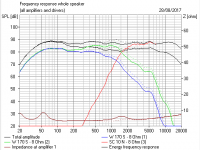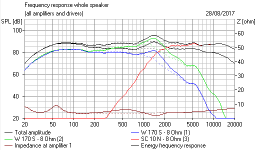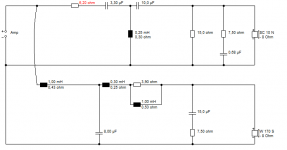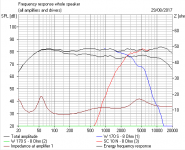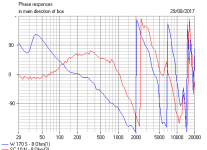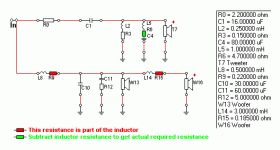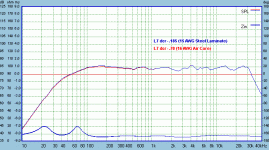I'm going to go out on a limb here; simple things.
If you look at the response of the individual drivers at Zaph's website you can see that the upper woofer has a peak around 800 hz. If the lower woofer phase were backwards it would cancel progressively more as frequency goes down producing quite an overall peak at around 800 hz. This fits with the lack of bass the speaker is producing. This however does not explain what is going on at higher frequencies.
This is what I would do. While your crossovers are gone hook up your two woofers in parallel (mounted in box with tweeter also) just to see how much bass they can produce. Should be lots.
Then afterwords you could hook up your tweeter in series with around 2.2 ohms in series for level (R0 in Zaph crossover) and ALSO a capacitor in series (around 4 uF for an F3 of around 6000 hz at 4 ohms). Do not play this loud.
With the tweeter and two woofers hooked up the speaker should sound reasonably ok and not irritating. If you use the auto equalize it should sound pretty good.
***Could someone please confirm if this is reasonable!!***
These speakers are just too good to give up on.
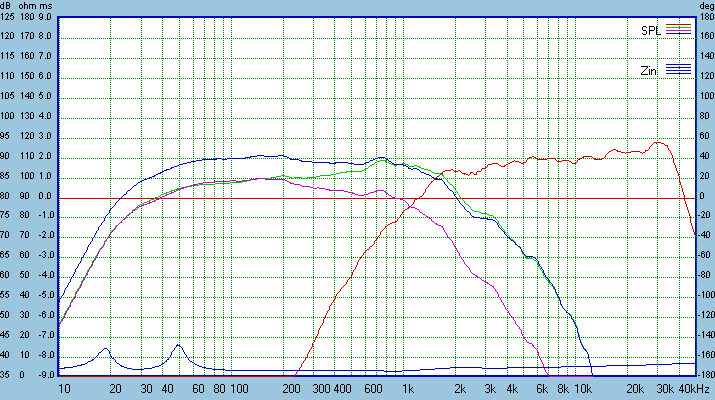
If you look at the response of the individual drivers at Zaph's website you can see that the upper woofer has a peak around 800 hz. If the lower woofer phase were backwards it would cancel progressively more as frequency goes down producing quite an overall peak at around 800 hz. This fits with the lack of bass the speaker is producing. This however does not explain what is going on at higher frequencies.
This is what I would do. While your crossovers are gone hook up your two woofers in parallel (mounted in box with tweeter also) just to see how much bass they can produce. Should be lots.
Then afterwords you could hook up your tweeter in series with around 2.2 ohms in series for level (R0 in Zaph crossover) and ALSO a capacitor in series (around 4 uF for an F3 of around 6000 hz at 4 ohms). Do not play this loud.
With the tweeter and two woofers hooked up the speaker should sound reasonably ok and not irritating. If you use the auto equalize it should sound pretty good.
***Could someone please confirm if this is reasonable!!***
These speakers are just too good to give up on.

I'm going to go out on a limb here; simple things.
If you look at the response of the individual drivers at Zaph's website you can see that the upper woofer has a peak around 800 hz. If the lower woofer phase were backwards it would cancel progressively more as frequency goes down producing quite an overall peak at around 800 hz. This fits with the lack of bass the speaker is producing. This however does not explain what is going on at higher frequencies.
Both woofers are definitely in phase. Hook up an AA battery and they both move the same way.
The severe dip at ~ 1kHz means to me that you may have the tweeter connected IN PHASE, which is likely incorrect......
Zaph's page shows the tweets and woofers in phase. I believe the documentation that came with the kit said so as well. Since it is easy to do, I tried reversing the phase anyway.... To my ears I can't even tell which way sounds better and really don't hear a lot of difference compared to before.... WTF?
According to Zaph "The 2.5-way crossover design is a cascaded configuration... The crossover is close to a 3rd order configuration, and as such there is no reverse null."
In general what I am suggesting is to start simple. I don't think implementing a new crossover on a design that is generally accepted as very good is going to help.
Two woofers in a cabinet hooked up directly to your amp should give you an idea of the kind of bass that these speakers can produce. Reverse the polarity of one and the bass will be much less. Not sure if you have actually done this without a crossover.
Add in a tweeter with a simple cap for protection and a resistor of level and you can get an idea of overall sound. Also use your eq to see if there is still a big spike at 1khz. There shouldn't be but obviously there will be some eq as you are now running the woofers wide open and a tweeter with only 1st order.
All this is to see if the stock crossover is producing the spike or maybe it is something else.
Two woofers in a cabinet hooked up directly to your amp should give you an idea of the kind of bass that these speakers can produce. Reverse the polarity of one and the bass will be much less. Not sure if you have actually done this without a crossover.
Add in a tweeter with a simple cap for protection and a resistor of level and you can get an idea of overall sound. Also use your eq to see if there is still a big spike at 1khz. There shouldn't be but obviously there will be some eq as you are now running the woofers wide open and a tweeter with only 1st order.
All this is to see if the stock crossover is producing the spike or maybe it is something else.
I just had a look at possible causes of a midrange spike at around 1.2kHz.
In fact the circuit does look about 2dB high at this frequency. Fitting a 0.7mH instead of 0.5mH was a possible cure. First FR plot.
If the 5R/60uF shunt is open circuit, it all gets very poor indeed. Second plot.
In fact the circuit does look about 2dB high at this frequency. Fitting a 0.7mH instead of 0.5mH was a possible cure. First FR plot.
If the 5R/60uF shunt is open circuit, it all gets very poor indeed. Second plot.
Attachments
Here is a rough idea of what I am looking at. This is what the auto eq wants to do to achieve a flat response. 1khz is at least 6db louder than the midrange and 9db louder than the upper treble?
Assuming that is reasonably accurate, it looks very much like a connection/phase issue. Is it possible the upper mid-woofer is out of phase? Perhaps try flipping the mid-woofer polarity and run the eq again with the mic roughly 1m distance and on-axis with the tweeter. Double check that the upper and lower woofer connections aren't switched (sometimes they aren't clearly marked on the crossover). The high frequency roll-off could just be the mic position/angle.
Last edited:
System7 can you reproduce the frequency response error the OP posted in #36 using stock crossover and reversing the polarity of each of the two woofers in turn? It would put the reverse polarity issue to rest. Hopefully this is a reasonable thing to ask.
I just had a look at possible causes of a midrange spike at around 1.2kHz.
In fact the circuit does look about 2dB high at this frequency. Fitting a 0.7mH instead of 0.5mH was a possible cure. First FR plot.
If the 5R/60uF shunt is open circuit, it all gets very poor indeed. Second plot.
I did have a .24mH inductor to put in series with the .5mH that is in there. It changed the sound a fair amount but did not get rid of the offending harshness that is really bothering me. The extra resistance in series did also make the tweeter level a bit louder. I'm surprised it was enough for me to pick it out.
System7 can you reproduce the frequency response error the OP posted in #36 using stock crossover and reversing the polarity of each of the two woofers in turn? It would put the reverse polarity issue to rest. Hopefully this is a reasonable thing to ask.
I put an AA battery on the crossover input and both woofers move out. They are wired in phase.
Anyway... I shipped out the crossovers to Madisound. I pray that they find something wrong with them as that would be the simplest issue to fix. If they say it sounds normal, and this is what they consider their best sounding kit, I don't know where that leaves me besides confused and disappointed. My room is a bit lively so some wall treatment and another rug will be happening regardless. Surely that will offer some relief.
I put an AA battery on the crossover input and both woofers move out. They are wired in phase.
That solves that....thanks.
TBH, I've always hated the 6" plus soft-dome combination. Terrible time-alignment problems especially in LR2.
How they laughed about 5 years ago when I said that soft-domes sounded spitty and harsh. They are not laughing now! Ring-radiators get a much better press these days. Even Troels Gravesen goes for them by preference.
However this disastrous sounding project turns out, I think it is recoverable. Anybody who crosses a 1" tweeter at 1.7kHz is just asking for distortion. I mean 16uF and 0.25mH second-order is just plain silly on a 1" tweeter! 🙄
IMO, almost everybody gets this combination wrong. My own opinion is that a BW3 alignment works incredibly well. Heybrook did it well enough back in the day with the HB2. We turn the time-alignment problem into a FEATURE with 90 degree BW3. I did some BBC-style passive bafflestep correction just because I enjoy this stuff. Impedance to die for. 😎
How they laughed about 5 years ago when I said that soft-domes sounded spitty and harsh. They are not laughing now! Ring-radiators get a much better press these days. Even Troels Gravesen goes for them by preference.
However this disastrous sounding project turns out, I think it is recoverable. Anybody who crosses a 1" tweeter at 1.7kHz is just asking for distortion. I mean 16uF and 0.25mH second-order is just plain silly on a 1" tweeter! 🙄
IMO, almost everybody gets this combination wrong. My own opinion is that a BW3 alignment works incredibly well. Heybrook did it well enough back in the day with the HB2. We turn the time-alignment problem into a FEATURE with 90 degree BW3. I did some BBC-style passive bafflestep correction just because I enjoy this stuff. Impedance to die for. 😎
Attachments
Hi merlinx76,
Did you manage to sort your speakers and find out what was wrong with them.
Very interested in this thread as I have a similar problem, different speakers but same configuration.
Rgds.
Did you manage to sort your speakers and find out what was wrong with them.
Very interested in this thread as I have a similar problem, different speakers but same configuration.
Rgds.
I was reading on another designer's site about the woofers, he feels that the woofers are not all that great for a 2-way and better suited for a 3-way due to coloration. Very nice base but the untreated paper cone does what paper cones do. I suppose that could be what I am hearing. I can't believe how people can really find these pleasant. I suppose they are pleasant on about 5 to 10% of songs if you only want to play music that your speakers like.
Is a laminate core inductor acceptable for the .5 way filter (L14)? I don't understand at what point cored inductors can cause issues or if they are ever a good idea really. Madisound uses one of their sledgehammer inductors in that location. All other inductors are air core.
Attachments
Look at the resistance of the two woofer inductors. Note that the air-core has one third the inductance, but one fifth more resistance. Look up the resistance and physical size of air-cored 3mh coils. You would have to redesign your crossover to use one. But consider the primary complaint against iron-core inductors- saturation at high power. Well, you would burn your voicecoils before you got to that point, and what happens if you do? The inductance becomes less(not non) linear at these levels you will never reach safely. PA crossovers have traditionally used iron-core inductors because they are needing tremendous volume, and do not want the extra heat producing resistance as they put hundreds and thousands of watts through their crossovers.
Also you will lose damping, and raise the Qt, which is why I said you would need a redesign.
If you are starting from scratch, at normal sub 120db levels, use what you want, it will sound fine either way, if your crossover is good.
If your drivers test out within tolerances, they are not your problem. So when you find out from Madisound what's up with the prebuilts, you can start thinking about how to match those very nice drivers in that box to your room(which, being the room, is the elephant).
You have a nice problem. You'll fig it out.
Also you will lose damping, and raise the Qt, which is why I said you would need a redesign.
If you are starting from scratch, at normal sub 120db levels, use what you want, it will sound fine either way, if your crossover is good.
If your drivers test out within tolerances, they are not your problem. So when you find out from Madisound what's up with the prebuilts, you can start thinking about how to match those very nice drivers in that box to your room(which, being the room, is the elephant).
You have a nice problem. You'll fig it out.
Well just to let those of you know who were interested, Madisound found nothing wrong with the crossovers when they tested them. They were reluctant to send them back being unable to find a problem and knowing that I was not happy with them. The guy I was dealing with (Adam) offered to sell some coils at cost for me to try to replace for the woofer crossover. I figured why not try it at those prices. I set it all up again with the new coils (air core on lower .5 woofer and a copper foil on the midwoofer). I didn't expect improvement but I feel there was some for whatever that's worth.
After that, I read some info online about setting EQ and tried in software to repeat the process. They suggested that I take a 1/3 octave EQ and boost each band one at a time to find the most annoying regions. I set the level to -12dB to avoid clipping and went through each individual band adding 12dB and found a horrible ring at 3.2kHz. I then dug up the 8531 spec sheet from Scan-Speak, and sure enough, that is the first peak of the cone breakup. Since my HT amp has a parametric EQ, I can do a very narrow cut at 3.2kHz and found this has also helped reduce that annoyance quite a bit. I think it would be better to try and incorporate a notch filter into the woofer crossover so that I don't cut the tweeter at that frequency as well.
After that, I read some info online about setting EQ and tried in software to repeat the process. They suggested that I take a 1/3 octave EQ and boost each band one at a time to find the most annoying regions. I set the level to -12dB to avoid clipping and went through each individual band adding 12dB and found a horrible ring at 3.2kHz. I then dug up the 8531 spec sheet from Scan-Speak, and sure enough, that is the first peak of the cone breakup. Since my HT amp has a parametric EQ, I can do a very narrow cut at 3.2kHz and found this has also helped reduce that annoyance quite a bit. I think it would be better to try and incorporate a notch filter into the woofer crossover so that I don't cut the tweeter at that frequency as well.
- Status
- Not open for further replies.
- Home
- Loudspeakers
- Multi-Way
- Zaph / Madisound ZRT 2.5 Problem
